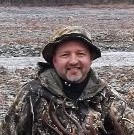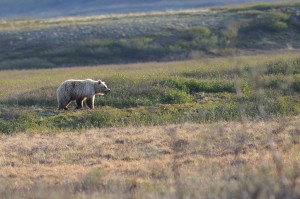We have much more to do and your continued support is needed now more than ever.
Visiting the Wild Western Arctic Reserve
 The following is a guest post from Larry Bartlett from Fairbanks, Alaska—he gives a firsthand account of traveling in the Western Arctic Reserve (also known as the National Petroleum Reserve or NPR-A), the single largest unit of public land in the nation encompassing 23.5 million acres. This land provides habitat for caribou, grizzlies, polar bears, wolves, and millions of migratory birds—including tens of thousands of ducks and geese highly valued by sportsmen throughout the nation.
The following is a guest post from Larry Bartlett from Fairbanks, Alaska—he gives a firsthand account of traveling in the Western Arctic Reserve (also known as the National Petroleum Reserve or NPR-A), the single largest unit of public land in the nation encompassing 23.5 million acres. This land provides habitat for caribou, grizzlies, polar bears, wolves, and millions of migratory birds—including tens of thousands of ducks and geese highly valued by sportsmen throughout the nation.
When Alaskans are asked about the National Petroleum Reserve (NPR), most have never heard of it, few have visited this region, and still fewer have hunted this barren landscape. That’s precisely the way I prefer it; wild, uncorrupted, scenic, stark, and extremely remote.
Most notably this region in Northwest Alaska serves two biological purposes:
- Spring breeding grounds for hundreds of thousands of migratory birds;
- Calving grounds and summer range for the Western Arctic Herd of caribou (the largest caribou herd in Alaska, numbering over 550,000 animals).
I’ve frequently visited the largest drainage existing within the NPR, the Colville basin, starting around 1998. Surprisingly, not much has changed in this region. It continues to provide wild and remotely scenic adventures to those who wish to endure its vastness firsthand.

Pristine Wilderness in the Truest Form
Most visitors begin trips to the northwest region starting in July, since breakup occurs in late June on these northwest rivers. Mosquitos are intense until mid August, so most of my personal travels occur during this time period to mid-September.
After spring calving season, caribou slowly begin a southwest movement from the Utukok uplands, across the Colville River, and continue southwest over the Continental Divide through river drainages and over broad mountain passes of the Brooks Range. Most caribou hunters pursue opportunities along major tributaries of the upper Colville and Noatak rivers.
A unique region, floaters often find bituminous coal chips washed up on the many gravel beaches of the Colville River and its tributaries. This region has abundant bituminous deposits close to the surface, and oil seeps can also be seen in this region, giving rise to the question of when, not if, these valuable resources will be tapped and exploited from the NPR.
As far as the “experience” floaters can expect, I’ve enjoyed many types, from hunting pursuits for moose and caribou to archeological finds to char fishing. It’s a great place to escape human encounters and soak up the wonder of this unexploited landscape.
Many fossils, such as mastodon and mammoth tusks, dinosaur bones, and ancient human remains, can be found jutting out from eroding high cliffs and along the shorelines of many clear-flowing tributaries of the Colville River. This region’s wildlife has experienced flows and ebbs of life and death for hundreds of thousands of years, and it continues to be considered one of the richest sources for scientific importance in all of Alaska. The first known inhabitants of North America are thought to have crossed into Alaska and to the Americas from Siberia across the nearby Bering Land Bridge as early as 15,000 years ago. Peoples in this region often buried their dead in shallow rock-covered graves, since permafrost prevented traditional burial practices. And these mounds can be located in sporadic locations across the tundra and near the banks of the Colville River, so visitors must travel with bright eyes and wary souls to spot these unique anthropologic treasures.
This region has a bounty of possible adventures; however, there are simply too many unique attributes to list that make up the whole “experience” of travelling to this region of Alaska. It’s a resource worth protecting from crude resource extraction, heavy human use and careless travel. Perhaps this region is best described as Alaska’s Northwest Gem, full of wonder, adventure, and historic importance.
Currently, the Bureau of Land Management is finalizing a management plan to determine which lands and waters will be protected and which will be leased for oil and gas development in the Western Arctic Reserve. Thanks to widespread support for conservation, they have identified a preferred plan called ‘Alternative B2’. This plan will preserve wildlife habitat for caribou, grizzly and polar bears, and millions of migratory birds in the Western Arctic.
Although this is a major step forward — we’re not over the finish line yet. It is important the management plan be finalized to permanently protect wildlife habitat in the Reserve.
![]() Please “like” and “share” our image on Facebook, to thank Interior Secretary Salazar and urge him to stand strong against pressure to open more of the Reserve to oil and gas development.
Please “like” and “share” our image on Facebook, to thank Interior Secretary Salazar and urge him to stand strong against pressure to open more of the Reserve to oil and gas development.





















